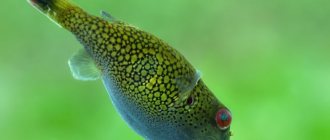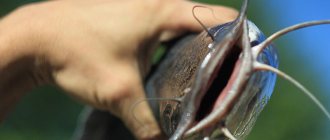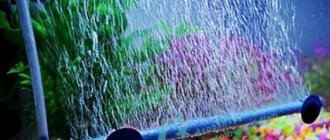Nile tetraodon or Fahak (Tetraodon fahaka) is found naturally in the waters of Africa. The fish belongs to the Pufferfish or Four-toothed family (Tetraodontidae). Under natural conditions, it reaches a length of up to 45 cm. It is a predatory and aggressive species. Maintains in all layers of water. Suitable only for species aquariums. Maintenance conditions: t 23−27 ° C, dH 12−15 °, pH 7.0−7.4, brackish water is preferred, good filtration and weekly water changes up to 20−25%. Aquarium from 250-300 liters with plenty of hiding places, hard-leaved plants and free space for swimming. It should be taken into account that only glass containers are suitable for transporting Fakhak, otherwise the fish may bite or puncture the plastic bag.
Food: live, frozen, in extreme cases, high-quality substitutes.
Fahakis become sexually mature at the age of 2 years at a size of about 30 cm in length. When breeding, a spawning tank of 200−250 liters is used with a layer of water of about 40−45 cm and a temperature of 23−27 °C. Before spawning, spawners are fed a variety of foods. It is advisable to change part of the water (up to 30%) daily. Fertility up to 6000 eggs. After spawning, the spawners should be removed. It is recommended to add methylene blue to the water. The incubation period lasts about 3 days. Starter food: ciliates, rotifers. Later - Artemia nauplii.
Description and habitat
Tetraodon belongs to the huge family of pufferfish or dogfish, which contains 29 genera and more than 200 species. There are both marine inhabitants and inhabitants of brackish and fresh waters.
These fish live in the tropics and subtropics of South, Southeast Asia and Africa, the coastal zones of the Indian Ocean, and Oceania.
The well-known Fugu, which only Japanese chefs with special permission have the right to cook (it is poisonous), also belongs to the pufferfish.
All fish of this family have a distinctive feature. Their body in a calm state is not too long, elongated, oblong, resembling a pear. But in a moment of danger, they swell greatly and turn into a warlike ball with spikes.
There are no scales on the body, only short spines pressed to the body. There are no pelvic fins, only pectoral fins. It is due to them that the fish actively moves. The dorsal crest is strongly displaced towards the tail.
A large fleshy head with a small mouth with fused jaws that form planes that serve as original teeth. That is why this family has another name - four-toothed.
The body swells due to pouches-growths under the stomach. When frightened, tetraodon swallows water in them and swells, straightening its spines. This makes the fish inaccessible to predators. Even if one of them decides to profit from such prey, death awaits him. Since the dangerous ball simply gets stuck in the throat, releasing poison.
All fish of this family are themselves either predators or belong to the class of omnivores.
You can meet pufferfish in the waters of the Sunda Islands, the Malay Peninsula, the Philippines, India, Sri Lanka, Thailand, Burma, near the coast of Japan, Cambodia, Myanmar, India, Vietnam, Indonesia, and Singapore.
Photo gallery of tetraodons:
The sizes and colors of four-toothed animals vary greatly depending on the genus and species. But brownish, greenish, yellowish tones predominate, and there are many spots on the body. The brightness of the color usually increases with age, especially in males; females are usually paler and smaller. Body length varies greatly - from 5 to 80 cm.
All varieties have large and protruding eyes and the ability to have peripheral vision. And the modified “teeth” serve as good protection and a means for grinding any food.
These fish have been known in the aquarium hobby since the late 19th century, at least in some freshwater species.
Description
Fahak is one of the largest and brightly colored tetradons, its maximum body length reaches 45 cm, weight - 1 kg. Its body is slightly elongated in length with a short caudal peduncle, its head is large, and its front teeth are double, like those of a rabbit. The lower part of the head and body is covered with small spines. The pectoral fins are well developed, the pelvic fins are absent. The dorsal and anal fins are short and located far on the body close to the tail. The body is yellow-green in color with wavy yellow stripes on the sides. It is almost impossible to distinguish a female Tetradon fahaka from a male, although during spawning the female becomes more rounded than the male.
Like all puffer fish, when in danger, the fahak quickly swallows water or air and, inflating a large air sac, takes the shape of a ball. When it swells, its spines rise and it is extremely difficult for a predator to swallow such a prickly ball. In addition, almost all tetradons are poisonous to one degree or another, and fahak is no exception.
Varieties of Tetraodon
Depending on the type of puffer fish, they are placed in marine species or river aquariums. Here are just a few of the varieties of tetraodon.
African tetraodons
These are inhabitants of the natural habitat of the lower reaches of the African Congo. Although they are freshwater creatures, they also love brackish water. The length of the fish is about 10 cm, the body color is from light to dark brown with yellowish spots and streaks and the belly is the same color.
Eight tetraodons
Two-eyed or curly fish are inhabitants of Southeast Asia, the Sunda Islands. The maximum body size is up to 10 cm.
The main color background is dark, brown, almost black. But the color of each fish is individual due to the yellow wide or narrow stripes that dot the body. The belly is white, becomes spotted with age and becomes slightly darker.
When viewed from above, two black spots stand out at the base of the dorsal fin closer to the tail. They are bordered in yellow and very much resemble eyes, which is why the variety got its second name.
The brightness of the color is not lost even in older individuals. Females are much larger than males. Young specimens are quite calm, but with age they become quite aggressive and actively guard their territory.
They love brackish water.
Green Tetraodons
Tetraodon nigroviridis is one of the most beloved species by aquarists.
Indeed, Nigroviridis is very beautiful, but this predator is quite difficult to keep.
This Asian and African subtropical underwater inhabitant has an amazing greenish-yellowish body color with large dark spots. Can grow up to 17 cm in length.
These fish are born in the wild during the rainy season and are therefore comfortable with fresh water. But for adults it is better to have a brackish pond.
Dogfish are predators, they are aggressive and toxic. It is better to keep them in a species aquarium. They are distinguished by high intelligence for underwater inhabitants, they recognize the owner and begin to happily fuss when he approaches the tank.
The spotted tetraodon constantly grows teeth; it needs to grind them down on hard food. Small snails are ideal for this.
It is difficult to breed in an artificial environment, but there are known cases of obtaining from a couple to two hundred eggs during one spawning.
Dwarf tetraodons
These fish are also called yellow for their characteristic coloring - a golden shiny body of short length (usually 2.5-3 cm, but some specimens grow up to 5-6 cm) with rare greenish or brownish spots. In nature, they live in the coastal waters of the Indian Ocean, Malaysia, Indonesia, and Indochina.
Males are noticeably brighter than females; their abdomen has a reddish tint during mating games. More peaceful than other species, but still these freshwater fish are predators.
Capable of breeding in an aquarium.
Tetraodons Kutkutya
Tetraodon cutcutia grows to 15-17 cm in length. Prefers salted water. Males are brighter than females, the color is yellowish or greenish with rare spots. This is a dangerous and poisonous predator. It is better to keep it in a species aquarium.
Tetraodons Fahaka
These are large ray-finned fish of the pufferfish family. They grow up to 40-45 cm, suitable for aquariums or special species aquariums.
Nile tetraodon prefers bottom habitat in fresh or brackish waters of rivers and lakes in Africa - the Nile, Niger, Volta, Gambi, Lake Turkana, Chad, Nasser Reservoir.
Tetraodon Mbu
This is the largest bottom-dwelling fish of the pufferfish order, about 75 cm long. It lives in fresh and brackish waters of Africa, in Lake Tanganyika. A very rare inhabitant of aquariums and large demonstration aquariums. Mbu meat is poisonous; this species has no commercial significance.
Description Tetradon Fahaka
Tetradon Fahaka has an elongated, pear-shaped body with bulging eyes and small fins. The upper part of the body is light brown with several horizontal stripes of white.
The belly of the fish is lighter and has a yellow color. In general, the colors can be brighter or darker, depending on many factors, such as the diet and age of the fish, as well as the habitat.
When frightened, like other Tetradons, Fahaka's Tetradon almost instantly absorbs a huge amount of water or air and takes the shape of a ball. The spines protrude, and the fish becomes difficult prey for larger predators.
Aquarium content
All tetraodons secrete toxic mucus in moments of perceived danger, so they should be handled with great care. It is not recommended to pick them up; you can feed them with tweezers. Like any predators, it is not recommended for beginners in aquarium keeping.
The most suitable species for home keeping are dwarf yellow and green spotted tetraodons. The first species is small in size and is able to live in fresh or slightly salted water.
Spotted tetradons prefer salt water.
In order for dangerous, but beautiful and exotic pets to please household members longer, it is necessary to create special conditions for them:
- The tank should be rectangular in shape and fairly spacious in size. Although the fish are small, it is better to choose an aquarium from 110 liters; it is easier to care for than a small one.
- Tetraodons react poorly to fluctuations in water parameters and composition. The optimal temperature for them is +22...+28 °C, acidity pH 6.5-9, hardness from 6 to 21 °dH.
- These fish love to be at the bottom of the reservoir, so although aeration and filtration in an artificial reservoir are necessary, the movement of the jets should be weak.
- Once a week it is necessary to replace a fifth or a quarter of the water volume.
- Tetraodons love to hide in shelters, which are well suited to thickets of plants. For example, vallinseria, elodea, nymphea, lemongrass, ferns, duckweed, riccia, cryptocoryne.
- It is better to use small pebbles as a bottom filler. You can bury a few oak leaves in the white one, and over time it will acquire a beautiful, noble shade of tea color. Siphon the soil weekly.
- A filter, compressor, heater, and lamps are a must in the aquarium. Although these fish are quite unpretentious when it comes to lighting. Heating the water is necessary when the temperature drops below normal, and on very hot days you can use plastic bottles with ice to cool the liquid in the reservoir.
- As additional shelters, it is necessary to make caves, grottoes, and houses at the bottom from decorative elements, stones, and driftwood. Tetraodons do not have scales, so the structures should not have sharp cutting edges or corners.
Nutrition
In nature, Tetradon fahak feeds on insects, mollusks, and crustaceans (crabs, crayfish and shrimp). In an aquarium, it can also eat small fish and frozen krill meat. Juveniles need to be fed every other day, reducing the amount to two to three times a week as they grow. Tetradons have strong teeth that grow throughout their lives. These fish need to be given snails and crustaceans to wear down their teeth. If the teeth grow too long, the fish cannot feed and must be cut down. Tetradons can also be offered tableted dry food, including those with plant ingredients.
Compatibility
None of the species of puffer fish can be called livable with their neighbors in an artificial reservoir.
If there is such an opportunity, then it is better to place the tetraodon in a separate species aquarium.
Although these are not schooling animals, as they grow older these fish acquire all the habits of territorial species and actively defend their habitat. Sometimes fights with even larger rivals lead to the death of the latter.
The only ones with which you can try to combine Tetraodon are Otoncyclus and the large shrimp. And this is provided that the tank is large enough and the aquarium fish do not lack food.
Breeding Tetradon Fahaka
Breeding this fish is problematic. Sexual characteristics are poorly expressed. Males are slightly brighter in color than females.
Spawning is stimulated with fresh water, increased temperature, and increased feeding.
According to the type of reproduction, these fish are divided into 2 groups: some lay eggs, which are then stored by the male, on the substrate, while others spawn in the water column, and the eggs begin to sink to the bottom or float. The eggs develop over 8-9 days. The female lays about 500 eggs at a time.
Feeding
Tetraodons must receive sufficient amounts of protein food. These can be snails, small shrimp, bloodworms, daphnia, tubifex, worms, crustaceans, and fry.
Sometimes you can give special dry food for predatory fish species. But it should be remembered that tetraodon teeth need tough and hard food, they must be regularly ground down.
If you purchase young tetraodons at the same time as juvenile zebrafish, rasboras, rainbowfish, and discus fish, you can try placing them in one large aquarium. But if the neighbors’ fins begin to suffer, then it is better to stop this experiment and resettle the dog fish.
Feeding Teradon Fahaka
Feed should be predominantly live food: snails, worms, insect larvae, mollusks, and other small fish.
COMPATIBILITY IN AQUARIUM
Tetradon fahaca or lineatus is extremely aggressive and should contain one. With success with other fish, he was kept only in very large aquariums with very fast fish that he could not catch. You can keep with related species only if they rarely intersect. Otherwise, they will fight every time they see each other. They are very smart and seem to be able to communicate with their owner using their unique facial expressions.
Reproduction
Not all types of tetraodon can be bred in an artificial reservoir. But the dwarf variety copes with this task quite well.
In this species, the male is larger and brighter than the female. During the mating season, its color becomes most intense, the dark stripe on the abdomen acquires a reddish tint, and the fins become sharply yellow.
To produce offspring, a couple must be placed in a spawning tank and created conditions that simulate the rainy season - raise the water temperature a couple of degrees, change it frequently, and plant thick algae there.
You can add several females to the male, since dwarf tetraodons lay only about a dozen eggs. And the presence of several females will be preferable; one may simply die from the aggressiveness of its partner.
It is impossible to place two males together during this period, one of them will certainly die.
Rare cases of green tetraodon laying eggs are no different from the process described, except that there are many more eggs - up to 200-300.
In this case, the responsibility for caring for the masonry is assumed by the male.
The fry hatch in a week and it is now better to remove the parents. As the juveniles eat their yolk sac, it is necessary to provide them with their first complementary foods. This can be live dust, then Artemia nauplii, crustaceans, and microworms are added to the diet.
Diseases and prevention
If the conditions of aquarium maintenance for tetraodons are observed correctly, then the dwarf species can live 3-4 years, larger varieties - longer, 5-7 years.
One of the important principles in caring for fishing dogs is to avoid obesity. To do this, you need to strictly monitor their diet and not overfeed. But depletion of tetradons is also unacceptable, the first signs of which are bloating of the abdomen and pale color.
This predatory species also has a high probability of invasive damage. Helminths most often penetrate into an artificial reservoir with low-quality, contaminated live food.
Newly acquired fish can also carry infections and parasites. Therefore, it is better not to immediately put them in a common aquarium, but to put them in quarantine for two to three weeks.
It is unacceptable to exceed the permissible norms of nitrates in the reservoir water. Filtration needs to be at a sufficient level; regular cleaning of the aquarium and rinsing the soil will also help. But if the tetraodon’s fins have enlarged and turned red, the fish often rise to the surface and breathe air, then poisoning has occurred. It is urgent to transfer them to a clean sedimentation tank and disinfect the main tank, change the filler, wash the walls and decorative elements, the bottom, change the water, pour zeolite into it.





